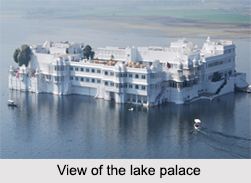 Lake Palace in Udaipur lies in the heart of Pichola Lake. It is located in the Jag Niwas Island. The Lake Palace was once the summer retreat of the Rajputs.
Lake Palace in Udaipur lies in the heart of Pichola Lake. It is located in the Jag Niwas Island. The Lake Palace was once the summer retreat of the Rajputs.
Architecture of Lake Palace
The rooms of the heritage hotel are decorated with arches and painted mirrors. Within the Lake Palace the travelers will come across Bada Mahal, Kush Mahal, Ajjan Niwas, Phool Mahal and Dhola Mahal. Though the palace has been converted into a hotel its basic layout still represents the Rajputana grandeur. Ethnic themes have been used to build this palace and it seems as if the palace is rising out of the azure waters of the lake. The pristine white marble of Lake Palace presents a striking contrast to the outstanding hue of the lake water.
 To pray to Surya, the Hindu sun God, the palace was constructed opposite east. At present the palace has been transformed into a heritage hotel. Hence an influence of Mughal architecture can also be seen in the palace. The courtyards of the palace are lined with pillared terraces, columns, gardens and fountains. The rooms of the heritage hotel are decorated with arches and painted mirrors.
To pray to Surya, the Hindu sun God, the palace was constructed opposite east. At present the palace has been transformed into a heritage hotel. Hence an influence of Mughal architecture can also be seen in the palace. The courtyards of the palace are lined with pillared terraces, columns, gardens and fountains. The rooms of the heritage hotel are decorated with arches and painted mirrors.
Re establishment of Lake Palace
Taj Hotels Resorts and Palaces took over administration of the hotel and further another 75 rooms in the year in 1971. One of the key people involved in the restoration, bringing it to such high standards with his work and experience was Jamshyd D. F. Lam of the Taj Group. In 2000, a second re-establishment was undertaken. The "Royal Butlers" in the hotel are offspring of the innovative palace retainers.
This article is a stub. You can enrich by adding more information to it. Send your Write Up to content@indianetzone.com



















